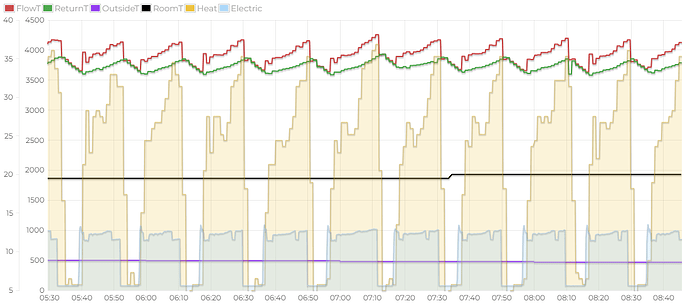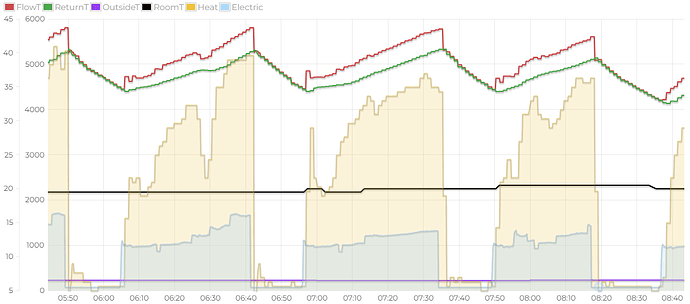Having played around with our office Ecodan 8.5kW over the last year I now have one at home.
It appears to be running more efficiently than the office one but that may be due to it being more appropriately sized for our house and oversized at work. It could also be errors in monitoring as the office one just has a flow sensor attached to the FTC but no electric meters so is estimating whereas at home I have an EmonHP level 3 setup.
One thing I have been experimenting with, now that it has started to get colder, is pure WC and Auto-Adapt. I have the FTC6 main controller in our hallway so the room temp is measured by that, no other controls.
I have noticed that currently the Auto-Adapt appears to be a bit more efficient and produce longer runs, although this is likely due to it being happier to overshoot on Flow Temp than WC mode.
Weather Compensation:
Auto-Adapt:
Note the Auto-Adapt one shown is on a colder day but hitting slightly higher COP.
I know that my radiator area is currently undersized, mainly due to the huge K2 column radiator lying on its side in the hallway rather than being plumbed in (need to get around to painting the wall first).
Also it isn’t ideal that there currently are no emitters where the room temp is being read from so it probably takes longer to get feedback after applying heat.
Hopefully there will be improvements once that radiator is installed and I might get the plumber to increase the diameter of some of the primary pipework as well (easily accessed in the cellar) allowing higher flow rate (and less noise).
I have TRVs open fully downstairs and in the bathroom and ensuite. The bedroom TRVs are set to limit the temperature to 19.5C. Unfortunately the downstairs is the least insulated bit of the house so the bedroom TRVs are mostly closed most of the time and are likely to be until it gets properly cold outside.
I’ve been experimenting with a MelCloud schedule to drop the temperature by 0.5C at night and raise it by 0.5C on the Octopus Cosy off peak periods.
My system is here at HeatpumpMonitor.org. The overall COP figure has been hurt by problems measuring heat output for DHW that appear to be resolving themselves (mostly air related).
Any comments or suggestions about the behaviour of my system would be welcome.

